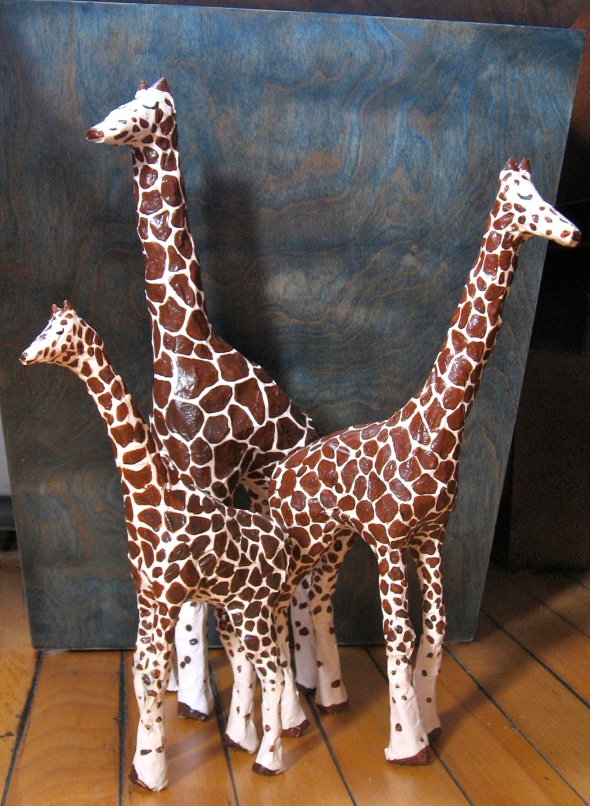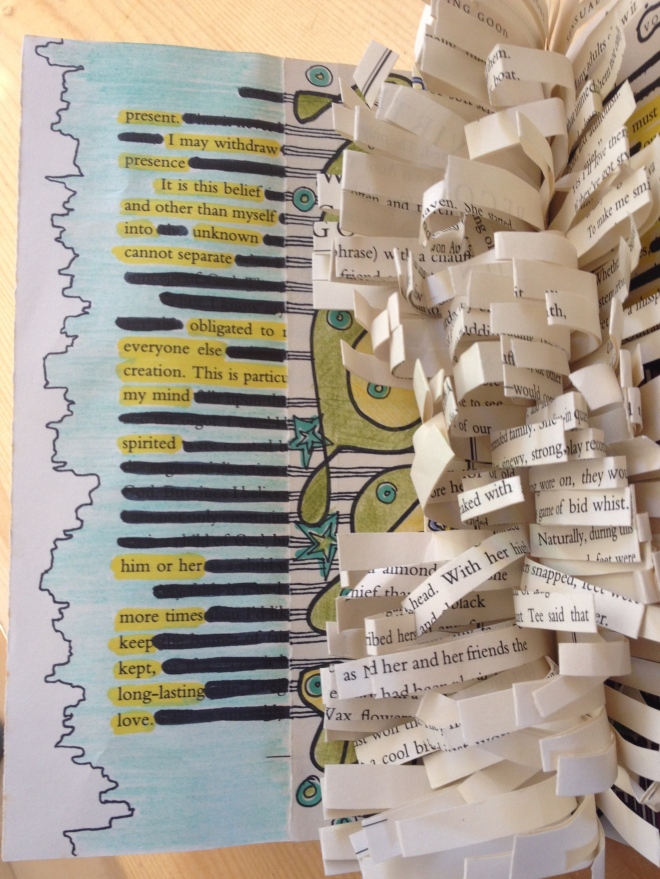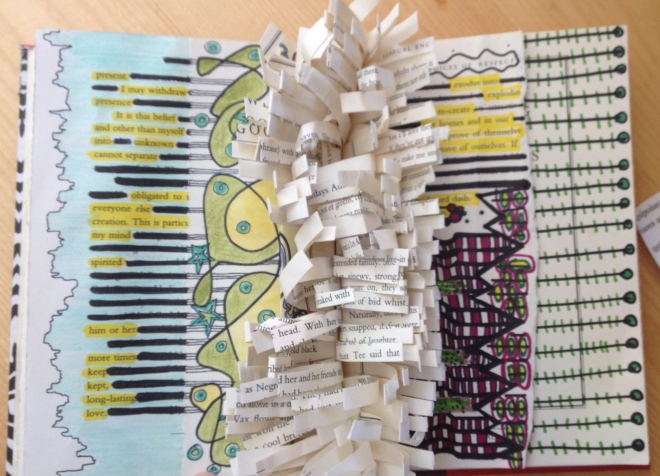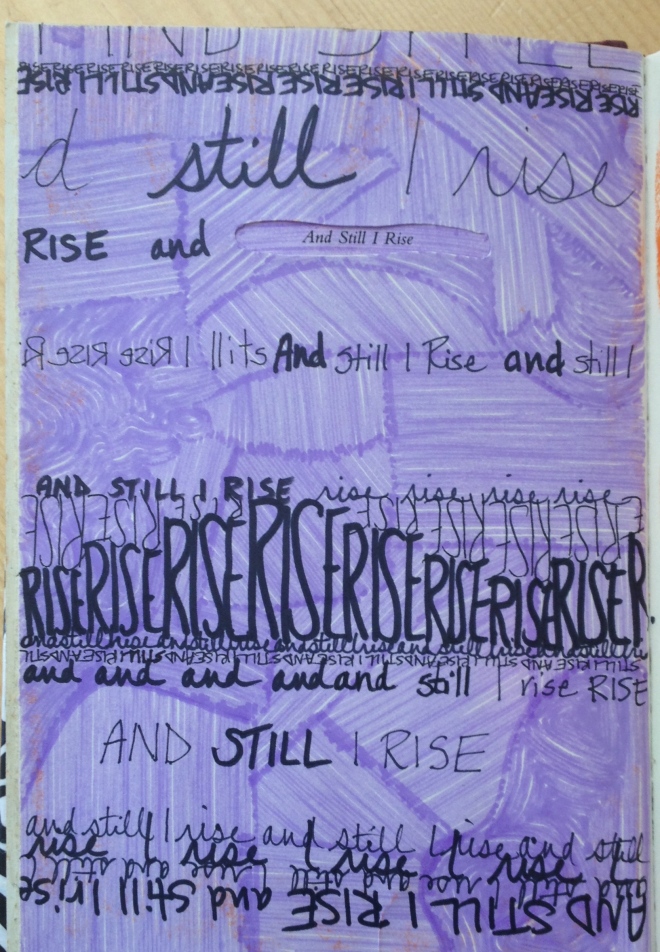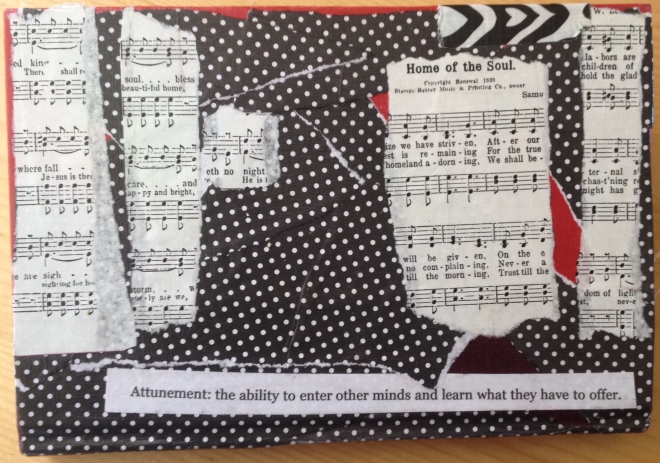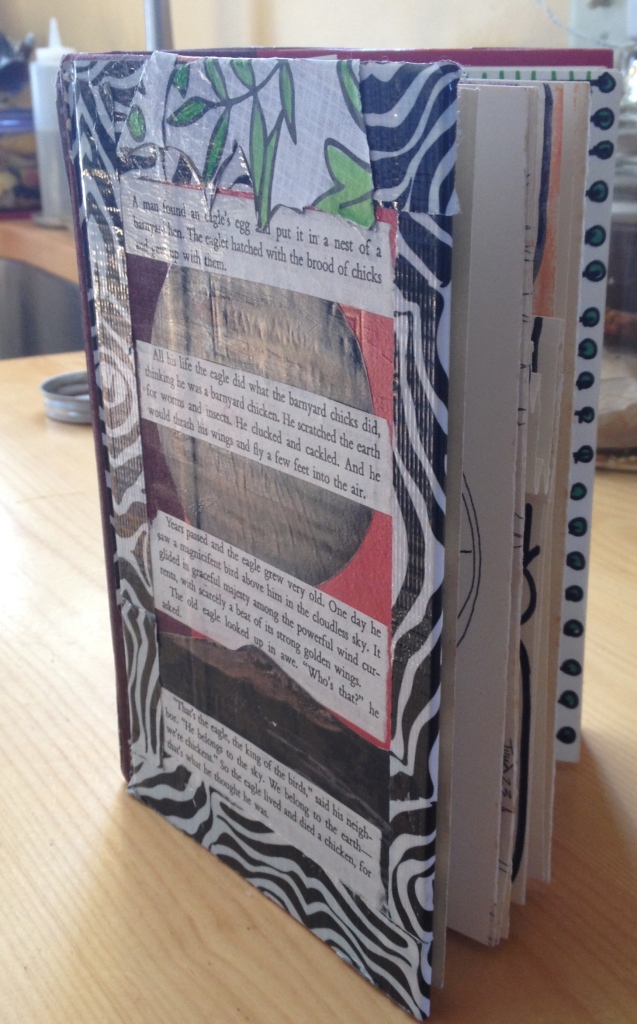My pronoun is “We”
Posted: April 25, 2024 Filed under: Art & Healing, Chronicles of a First Time Parent, What is an Art Farm 1 CommentDuring my student days, reading Greek and Latin literature, the heavy hitters – grammatically speaking – were the nouns and verbs; adjectives and adverbs lived the fancy life, drove fast cars, added sparkle and pizazz to any sentence. Pronouns were back bench utility players.
In recent years pronouns have gained a place of prominence, which intrigues me. I first heard about the increasing awareness of pronouns when a friend, serving on the Board of the Friends School of Portland, described this new phenomenon. My children’s teachers now list their pronouns in emails. I am increasingly aware of this social trend.
In my work as a carpenter no one ever asks my pronoun; this topic is never discussed on the job site. And so I should like to announce here, that my pronoun is “We.” I have chosen the first person plural with specific intent, to message my commitment to collaborate, co-create, communicate and cooperate in building community.
I observe people use the third person: he, she, it, they, them. First and second person pronouns do not denote gender, while third person specifically denotes and identifies gender. While I affirm and embrace gender fluidity, my deeper concerns lie with the increasing fragmentation and divide within our culture. Third person pronouns denote “other” which underscores separation.
The concept of “other” has been a central question of philosophy for centuries, for millenia. Within the European tradition everyone from Hegel to Husserl from Sartre to Simone de Beauvoir has opined upon “other.” In the main, “other” has been used to define “self” but I argue this falls within an “us versus them” mindset. What will it take for us to come together?
We do well to look further back to Plotinus, the Greek founder of Neoplatonism. He taught there is a supreme, totally transcendent “One,” containing no division, multiplicity, or distinction; the “One” was identified with the concept of “Good” and the principle of “Beauty.” Among his quotes is: “When we look outside of that on which we depend we ignore our unity; looking outward we see many faces; look inward and all is one head. If a man could but be turned about, he would see at once God and himself and the All.” First person plural, indeed.
Among the ironies of history is that a slave-holding patrician wrote that sterling sentence which begins “We the people of the United States, in order to form a more perfect Union….” How bold to set down those words, such pioneering thought, while Europeans were focused upon “other.” But slavery, treating some people not only as other but as property, bought and sold, would come to define the central challenge of the United States.
And so it was on 4 March in 1861 that an axe wielding brawny frontiersman, elected the 16th President of the young United States, stood upon the Capital steps, charged with the responsibility of holding together the Union. Abraham Lincoln’s First Inaugural Address outlined his thinking, a constitutional lawyer, on the civil discord simmering among the states. He closed out his speech with an appeal to unity, using the first person plural: “We are not enemies, but friends. We must not be enemies. Though passion may have strained, it must not break our bonds of affection. The mystic chords of memory, stretching from every battle-field, and patriot grave, to every living heart and hearth-stone, all over this broad land, will yet swell the chorus of the Union, when again touched, as surely they will be, by the better angels of our nature.”
If pronouns are to continue to gain in prominence, when the collective id has been let loose, when dark anger rages like a sharp knife in a street fight, in these times now going forward may we the people pursue the blessing of unity, accepting diversity in collaboration and a renewed commitment to community.
May “We” become the vogue, in these times, and going forward.
Crossing the Rubicon, crossing a cultural divide
Posted: March 31, 2024 Filed under: Art & Healing | Tags: art, exhibition, myth, mythology, spirituality 3 Comments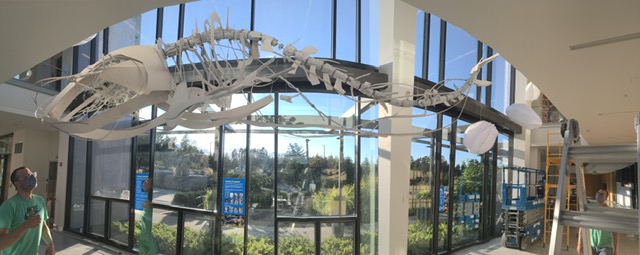
In 2000 I built, with Andy Rosen, a 25′ sculpture of a North Atlantic Right Whale. The sculpture was part of a collaborative exhibit, about our relationship to the rapidly warming Gulf of Maine, on display in two locations since then. The second exhibit recently came to an end, but as fortune blessed us, we have been able to donate the entire exhibit to the Wabanaki Public Health & Wellness Center in Bangor, Maine.
On the leap day, 29 February, I delivered the whale et al to the Wabanaki Public Health & Wellness Center. I was greeted by enthusiastic people, who welcomed our gift, and all of whom bore a similar resemblance. These were “people of the first light” members among the First Nations, and I powerfully realized that in crossing the Penobscot River I also crossed a cultural divide.
“Sea Change” within my/our culture was “other,” a puzzle, an odd fit. It had been well reviewed in the Sunday Press Herald and approximately 60,000 people experienced the exhibit. But we had a hard time getting people to embrace it, institutions especially. A robust PR campaign was promised, but in the end little was done to promote the exhibit. The board seemed to hold it at arms length while the administration neither recognized our donors, nor even acknowledged our “in kind donations.” One of our artists summed it up, “Our exhibit pushed some buttons that the museum was uncomfortable with….” One has to wonder.
We were invited to meet with a local ocean research institute to move the exhibit there, including an educational outreach, but their leaders rejected it, in part because of political issues; they directly said they could not take the whale because it touched upon the fisheries issue. Their major supporter is the fisheries industry. So our exhibit had run its course, its welcome worn out, and would have been hauled to the landfill.
To the Wabanaki it is a cherished asset, which they will use to help teach future generations (emphasis plural) about their link to the land. They welcomed my delivery not as plywood and tree trunk, not as wire and fabric, but a component of health and wellness. Their community has serious issues of addiction and mental health; in fact, alcohol, substance use and mental health disorders, suicide, violence, and behavior-related morbidity and mortality in American Indian and Alaska Native communities are disproportionately higher than the rest of the U.S. population. Our exhibit will be expanded into an immersive permanent exhibit in the Cafe of their Bangor center, showing the integration of life, the sustaining power of the Penobscot River, the grand web from Katahadin to Cashes Ledge, that all life is one.
What to my/our culture had become detritus is, to the Wabanaki, a most obvious opportunity. This has come to challenge me in a way reminiscent of paradox to Kierkegaard.
In the Oxford English Dictionary myth has two definitions. The first being “a traditional story, especially one concerning the early history of a people or explaining some natural or social phenomenon, and typically involving supernatural beings or events” with the second “a widely held but false belief or idea.” To my mind, in common parlance myth has become a pejorative term.
Carl Jung wrote, ““Everything that the modern mind cannot define it regards as insane.” Within our Western tradition of rationalism, dominated by monotheism, it is striking to note that one of our Great Men, the maven of rational insight and the material world, Sir Isaac Newton, led a secret life as a leading alchemist. He refused to publish his alchemical work – indeed, it was burned in a fire – perhaps for fear of scorn and rejection. The English Crown issued severe penalties for alchemy, including public hangings. Within our culture heretics have been burned at the stake, and witches sentenced to death.
Art-making predates agriculture, and thus predates civilization. Archetypes would seem to predate religion. Jung thought so, observing that organized religions had perfectly adapted the archetypes to their ritual stories. He wrote this not to denigrate religion, but, as a man of science, to pursue his “study of the soul.” The word archetype is derived from the Greek ἀρχῇ which is also, interestingly, the first noun [Ἐν ἀρχῇ ἦν ὁ Λόγος] of the “Book of Books,” the dominant sacred text within our Western tradition.
The word “archetype” first appeared in the English language during the 1500s, and conceptually relates to the Platonic forms, so I feel on solid ground considering them a priori and the religious narrative secondary. I am growing in certainty that archetypes may be the keyhole through which the light of consciousness shines, with myth providing the keys to unlock the “many rooms in my Father’s house.”
The act of making, to my mind, then is one means to manifest these truths.
Allow me to close with this story from the First Nations:
Whale witnessed the events that led to the settling of Turtle Island (North America) and has kept the records and knowledge of the Motherland alive. It is said that Mu (the Motherland) will rise again when the fire comes from the sky and lands in another ocean on Mother Earth. All of Earth’s children will have to unite and honor all ways and all races in order to survive.

Removing Obstacles
Posted: November 24, 2019 Filed under: Art & Healing, Gallery - Visual 1 Comment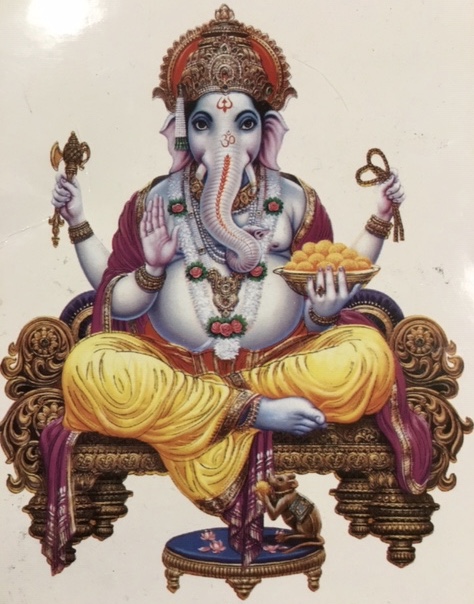
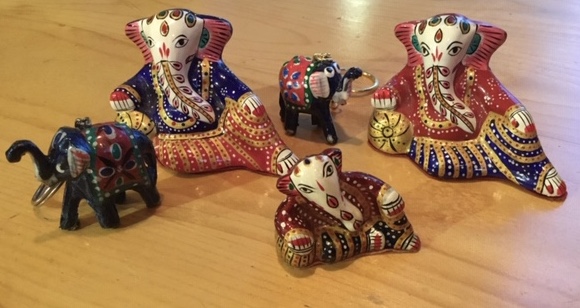
Ganesha has become a comforting figure to me. He is the remover of obstacles and master of wisdom and knowledge. A beloved friend attended the festival of Ganesha in India. She brought with her, an item from our home and placed it on an altar during the festival. I’ve continued to find him in lots of places, or maybe it’s the other way around.
Since my last post, regrettably over a year ago, I have struggled with how to incorporate my surgical screws into some creative effort.
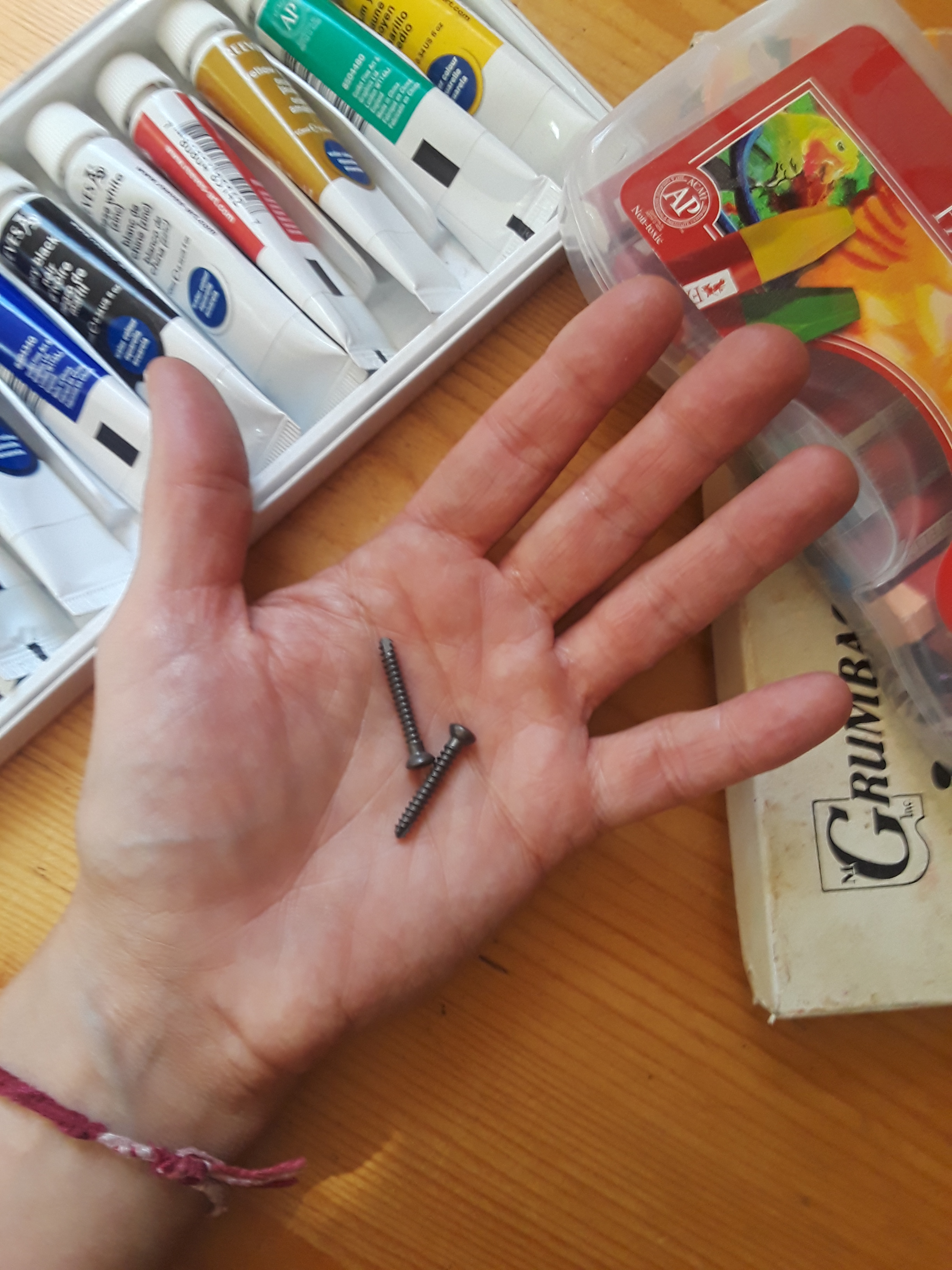
Recently, I’ve been experimenting with clay and simple sculpture materials to recreate my perception of Ganesha, holding symbols of personal obstacles.
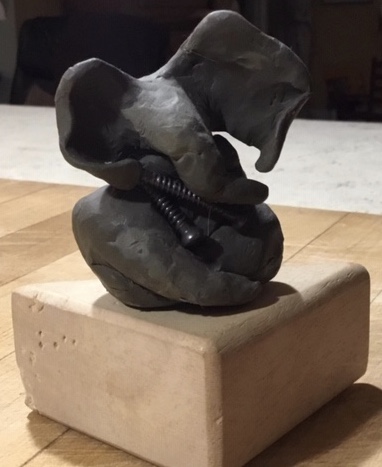
To be continued…
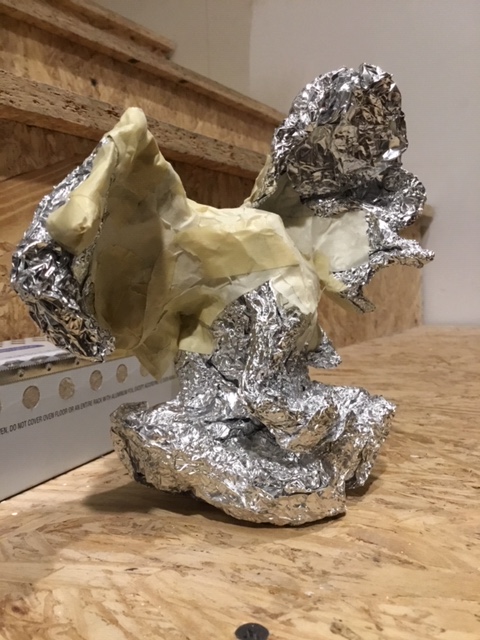

Destruction/Creation
Posted: October 26, 2018 Filed under: Art & Healing 4 CommentsTwenty-five years and 5 surgeries later I’m still healing from an accident which changed my life. Two friends died in a car accident and I was spared. I walked away. I did not know that both of my feet were injured and continued to not know until 13 years later when arthritis and bone spurs brought intense pain when I walked.
A lot of life has happened in 25 years. I am married to an incredible partner and have 2 beautiful, strong-willed, compassionate and creative children. I have a fulfilling career where I try to connect with and support others on their paths to healing and recovery.
Surgery 3 weeks ago removed 2 screws which have been keeping my left, big toe joint from bending. I feel compelled to use these objects in some way that transforms them from what they were into something new. I’m still trying to make sense of what happened so long ago and here is another opportunity to try.

Redefining & Reframing What it Means to be SAFE
Posted: July 29, 2016 Filed under: Art & Healing 2 CommentsWhat is safe, what is unsafe?
What does safety look like, feel like, sound like?
How do you know when you are safe?
How do you know when you are unsafe?
I ponder these questions as I go deeper into my work with little ones, grown ones, and the ones in-between. With dialog and art media we explore stories of struggle, threats to safety, resilience, set-backs, side-steps and efforts to move forward.
I created these sculptures from the same foil/tape method as used with the starfish and giraffe series. I will complete with acrylic paints once they are ready. For me, the shells represent a familiar, innocent and straight-forward form of safe space and protection. Often, in my clients’ experiences, there is no familiar, innocent or direct connection to this most basic need.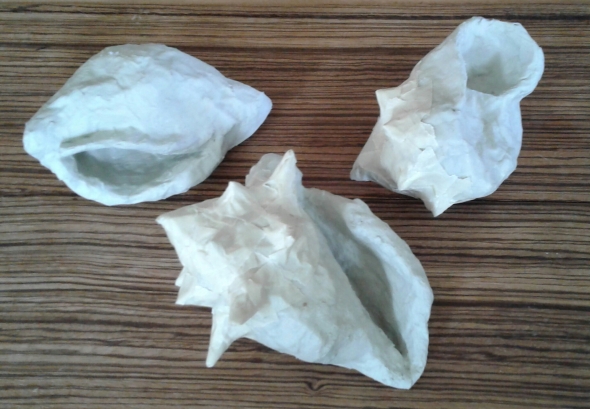
Starfish Galaxy
Posted: November 23, 2015 Filed under: Art & Healing 3 Comments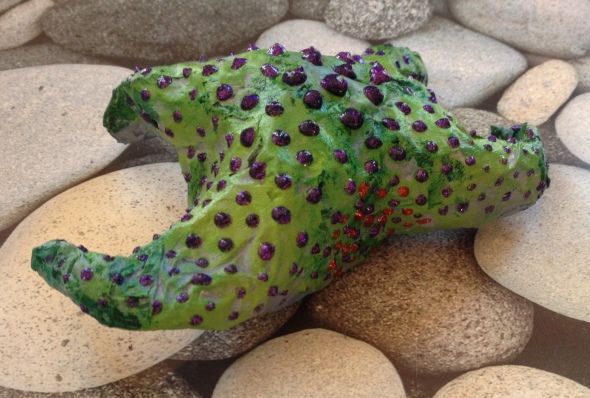 Continuing to explore the experience of resilience and survival and what it looks like through metaphor and sculpture. Materials include aluminum foil, masking tape, acrylic and puff paints.
Continuing to explore the experience of resilience and survival and what it looks like through metaphor and sculpture. Materials include aluminum foil, masking tape, acrylic and puff paints.
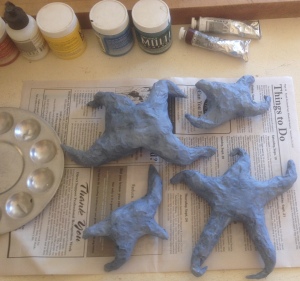
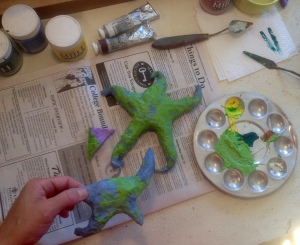
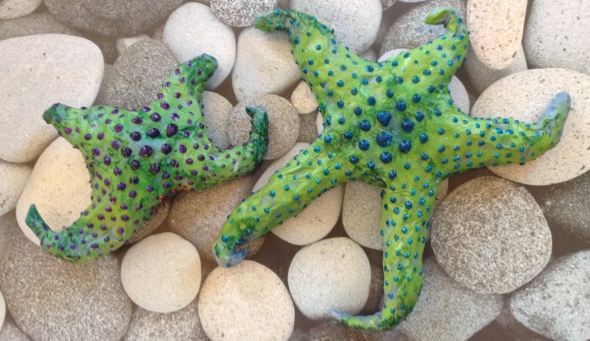


Playful Processing & Integration
Posted: September 2, 2015 Filed under: Art & Healing, Child Centered Activities 4 CommentsMy daughter was present and engaged during my post surgery recovery in 2011. She worked healing magic on me as well as her dolls and lovies.
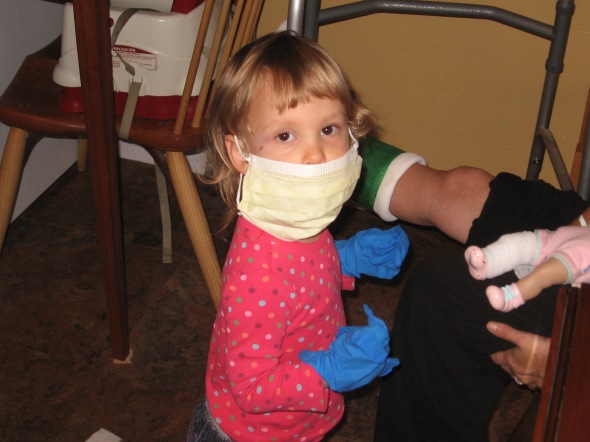
Colored tape, bandages, hugs and kisses…bedside with mama for those many days of recovery.
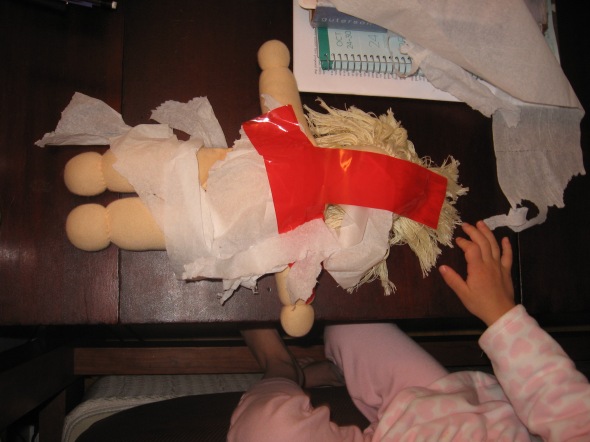
Today my daughter, aged 6 and headed for her own surgery, visited a most wonderful, child oriented surgery center where she was offered a child’s vantage point on what to expect. Once home, we spent the next several hours acting out the new information using whatever props and subjects we had close at hand.
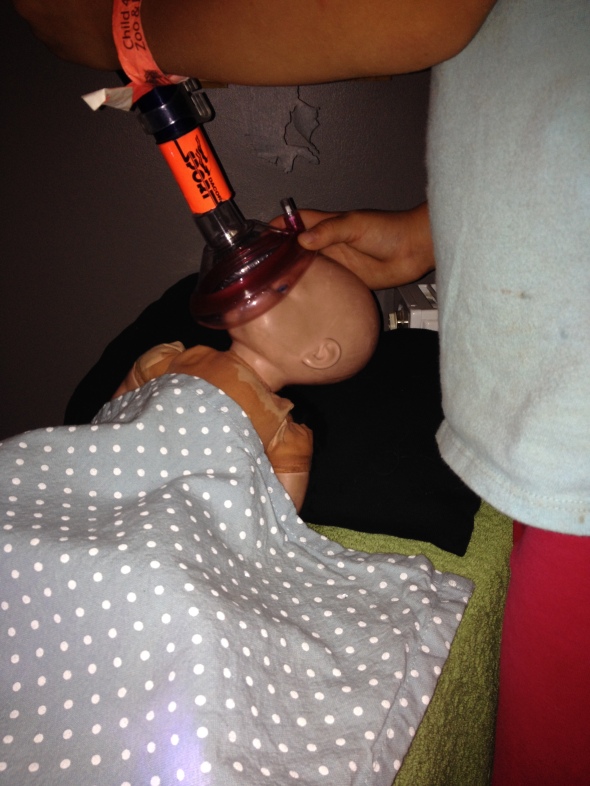

Witnessing Resilience and the Will to Survive
Posted: August 13, 2015 Filed under: Art & Healing, Gallery - Visual 1 CommentI’ve created a scene using sculpture to reflect the process I often experience when working with children and adults.The giraffes are watching the birth of starfish in varying stages of loss, pain and regrowth. The resilience and determination is often so great that one can only give thanks for being allowed to witness such spirit.
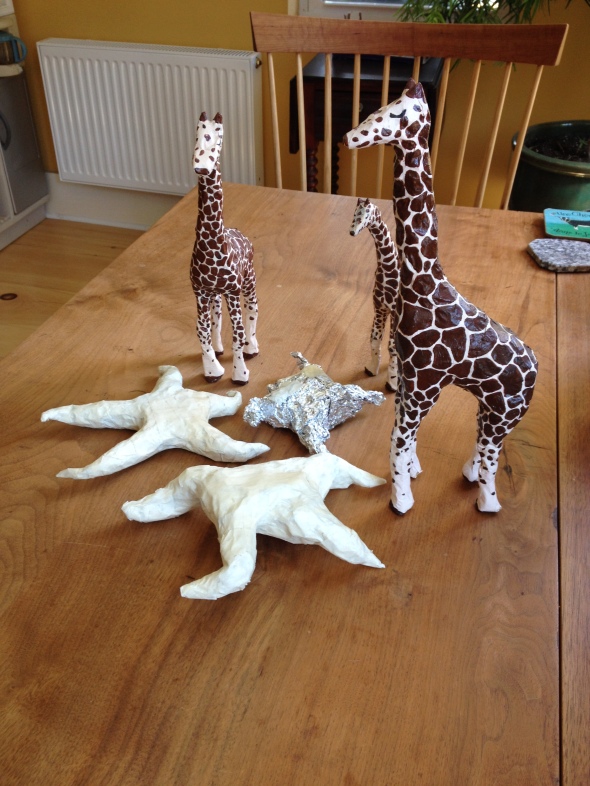
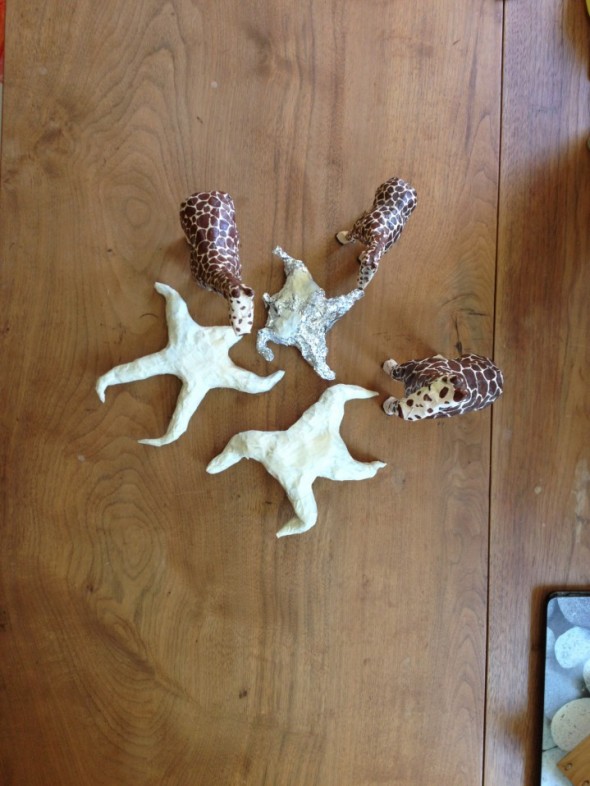
Project: Hope Process, Process Hope
Posted: July 17, 2015 Filed under: Art & Healing 3 CommentsThe giraffes have long awaited the next members to the foil/tape sculpture family.
A single starfish has emerged which seems to sing of loss, hope and rebirth. When an arm is lost a new grows back. Loss is so clearly a point of transition from one state to another.
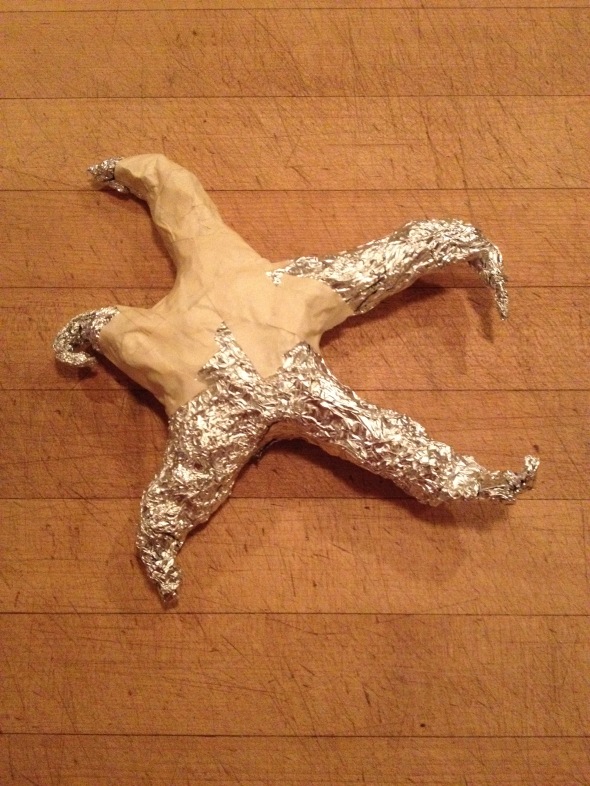
There is no stagnation only movement towards rebirth. Let the process shine.
Altered Selves
Posted: March 29, 2015 Filed under: Art & Healing, Gallery - Visual 3 CommentsIn my work as an Art Therapist and Licensed Counselor, I am helping adolescents and adults dealing with substance abuse issues. We have been creating “altered books” as a means for journaling and self-expression. I have come to see the altered book as a metaphor for the physical body, and its alteration from substance abuse.
I am using hardcover books – cast-offs gathered from friends and the local Goodwill thrift store – that my clients have reinvented and redefined to hold words, images and transformed paper; the altered book releases feelings and communicates ideas. Covers are collaged and fixed with Mod Podge, and then about 1/3 of the existing pages are torn out from the book to relieve the binding and allow space to add new works.
This has been a powerful art experience for everyone. While there are wildly creative and endless possibilities, here are a few images from my own journal just to give the idea. A special thanks to those friends who have rallied to collect books for this ongoing project.
